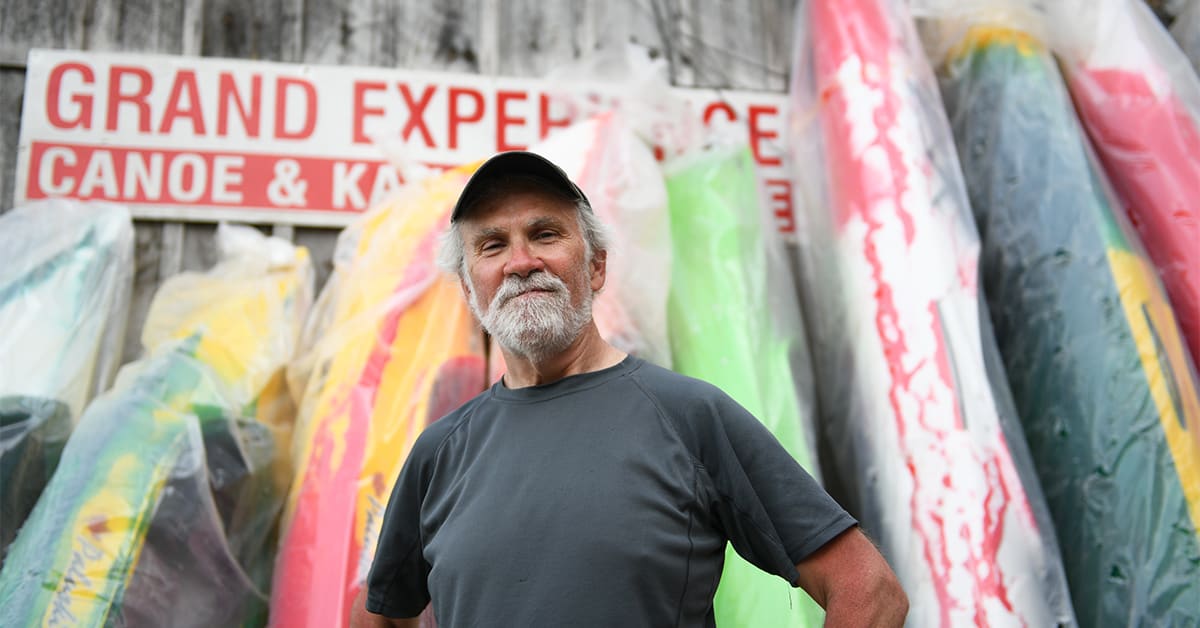On an uncharacteristically hot day in May, the sun is as ferocious as it is in August. I’m worried because I didn’t bring a hat, and I’ll be out in the sun with no cover for the next four hours.
I’m about to go white water kayaking on the Nith river. Yes, the Nith.
My guide is Jamie Kent, the owner and operator of Grand Experiences, an outdoor adventure company based in Paris. He and his team lead people on hiking, biking and canoe tours and even white water trips in southern Ontario.
Kent has assembled a crew of guides to accompany us down the Nith: Jason Wall, an all around certified outdoorsman, Naomi Henry, a student in training to become a primary teacher, and Sharon Boyd, a recently retired teacher who spends her summers guiding for Kent.
After meeting at Kent’s downtown Paris shop, we pile in the cargo van and make our way to Canning where Kent has another staff member waiting with the kayaks. From here we will paddle 17 kilometres to where the Nith enters Paris at Lion’s Park. And that’s where things will get challenging.
The Nith is a secretive river. The headwaters begin near Millbank and Crosshill, and then it winds its way back and forth, back and forth, through Nithburg, near Wellesley, Philipsburg, Luxemburg, New Hamburg, Haysville, Plattsville, Ayr, Canning and then to Paris where she empties into the Grand River. She winds through the background of rural life, going largely unnoticed, says Kent.
“People just have no idea it’s there. And the area, it’s not a river that’s easily accessible. There’s not a lot of trails on it, not a lot of road access to it, there’s very little of that. So most of it’s kind of hidden away in the back areas, right? In rural areas. And not very much access, people don’t see it much,” he said.
Kent says for most of its course, the land the Nith is on is fairly flat so the river has a gentle slope of four feet per mile. Just before it hits Paris, the elevation steepens sharply to drop 20 feet per mile. The sharp change generates rapids.
The best time to paddle these rapids is from March to early May, and then again in October and November when the water level is high from rainfall and snowmelt, said Kent.
The Nith is unpredictable because it is largely undammed. This means the water level can change quickly based on weather and precipitation.
“It’s much more of a personality that depends on the weather and the rainfall,” said Kent. “So the downside of not being dammed, it doesn’t have reservoirs to supplement the flow when you get a dry period. But when it gets wet, it gets a lot more flow. And so for doing whitewater, that works out great.
“You have to learn how it works. And from years of experience of watching it, you learn to know what kind of rainfall will make what kind of flows and you can forecast like at least a week in advance.”
Since the bottom of the Nith is mainly sand and gravel, with fewer boulders than more well-frequented white water rivers in Canada, it’s a great place for people to learn how to white water paddle, said Kent. “It’s more forgiving.”
Today because of the recent heat wave, the Nith is running quite low, at about 6.5 metres per second. Kent says he’s paddled the river when it was running as high as 300 metres per second.
When it runs any higher than 40 metres per second, paddlers can’t use a canoe because it’ll be swamped in the rapids.
It’s easy to underestimate the Nith, said Kent. “I’ve seen people who’ve moved in capsized pretty dramatically and had some scary stories.” in that it had some scary stories.
Jason Wall, one of Kent’s guides says he likes how close the Nith is. He usually drives up north to experience nature. “(The Nith) has everything,” he said. “White water to play and it’s literally in your backyard,” he said.
“I like the fact that it’s quiet,” said Boyd, another guide. “There’s not a lot of people until you get close to Paris, so there’s a greater chance of seeing wildlife because it’s quiet,” she said.
I’m impressed with how intimately Kent knows the Nith. He knows every bend, every hazard, every spot with irregular currents, every shallow spot, and the best way to navigate around them.
He wasn’t always a river guide. Kent said he started off in research and development for Proctor and Gamble, he also worked as the manager of the Burford Home Hardware but realized he wanted something else. At the encouragement of his wife, and after a year of planning, he started Grand Experiences in 1997. He began by guiding trips on the Grand River, and eventually by 2001 branched out to the Nith. Over the years, he’s spent a lot of time on these rivers; he can literally paddle the Grand blind. He cares deeply for them.
The Nith River makes its way through Carolinian forest. Only one per cent of Canada is classified as Carolinian zone, yet it includes some of the most biodiversity in the country, and most of the rare species as well.
“What I worry about is development. You know, too much development along the Nith, because it’s such a cool spot.”
He worries specifically about a new development in a forested area on the edge of Paris where deer used to live. Now the deer are crowding together in another patch of forest upriver.
As we made our way down the river, I had to practice my paddling skills when the river current picked up and pushed me toward various obstacles. At one point the river pushed me toward a fallen tree covering the water in a tangle of sharp branches—called a strainer in the kayaking world.
At another point, the river pushed me toward Devil’s cave – a phenomenon caused by hundreds of years of water swirling in a gathered intense spot, effectively drilling an estimated 20-foot deep hole into the limestone.
At one point this hole was located in a cave, but it collapsed. Now a chunk of stone lurks in the hole unseen beneath the surface. Over generations, the unseen chunk of stone has killed or nearly killed multiple kids diving in headfirst to show off their bravado, said Kent.
Just before the point where the river’s elevation starts to drop, we stopped at a pebbly and sandy shore to stretch our legs and put on our kayak skirts. The skirts attach to the kayak body and cover the opening where you sit so that water sloshing across the kayak from the rapids will not swamp the boat.
I have to admit, as we closed in on the rapids, my senses were heightened and I was feeling nervous. I’ve grown up paddling every summer, but never through rapids.
They were exhilarating.
As I made my way through the three sets of rapids, I became an observer of myself as my instincts took over and my muscles kicked in to paddle hard and do what was needed to avoid smashing into rocks.
Even with the water levels low as they were, the rapids still presented a challenge for a newbie like me, with waves rushing entirely over the lip of my kayak. At one point, I almost flipped into the water, but Jamie watched it all about to happen, and shot forward to catch me at the last moment.
Who would have thought the placid Nith River which quietly weaves its way through the back fields and woodlots of Wellesley Township, could have such a fun secret just before she empties into the Grand?
I will definitely be back.









